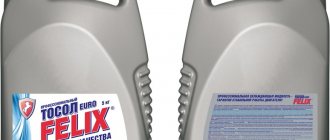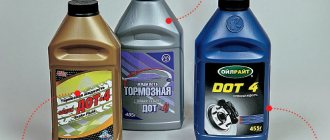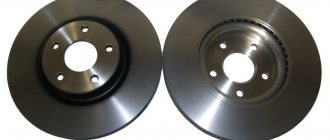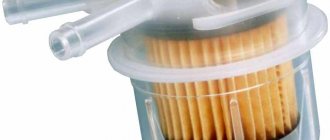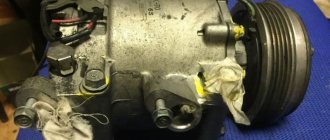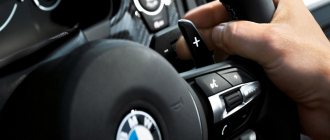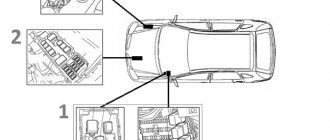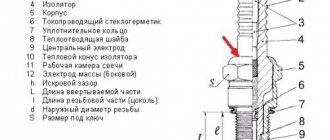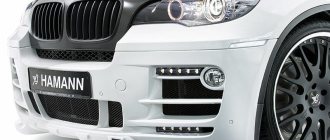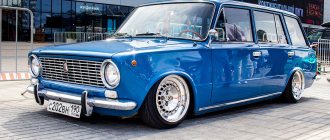Today, the automobile market is filled with various types of goods, the sea of which is quite difficult for the average consumer and novice motorist to navigate. This also applies to antifreeze, which is presented in car stores by many brands, manufacturers and a variety of color palettes.
Coolant attracts with a variety of colors, from turquoise to purple. How to understand which antifreeze or antifreeze is better, what is the difference between pink liquid and blue? This article is devoted to this topic.
Antifreeze
Antifreeze appeared in the Soviet Union along with the VAZ. For a new vehicle (with new materials in the cooling system), an antifreeze with better properties (than antifreezes available at that time) was required. Such antifreeze was created at the State Union Research Institute of Organic Chemistry and Technology by employees of the “TOS” department (“TOS” is abbreviated as “organic synthesis technology”), hence the name “T_O_S_ol”.
The full story is below. In the USSR, TOSOL became something like a trademark or commercial name. Although it would be more correct to say that it was a certain standard of antifreeze, since it was a coolant with a given composition and properties, but produced by different enterprises.
Today, TOSOL has become simply a common name for coolant (just like “copier”), produced in Russia (or the CIS) with a quality level ranging from very high to downright crap.
Despite the fact that coolant, ANTIFREEZE and antifreeze mean essentially the same thing, today (according to STABLY established PEOPLE terminology) the following concepts have come to be understood:
- ANTIFREEZE - imported coolant, usually of high quality (although, I think, in our country there can be anything on the shelves), often concentrated (but can also be ready for use)
- TOSOL is a domestic coolant of various qualities (from high-quality coolant to colored water), usually ready-to-use (i.e., not requiring dilution)
DOMESTIC ANTIFREEZE is a now outdated (but still living) commonplace concept of coolant, produced for trucks (although today the same liquid with a very different composition is poured into trucks, sold under the single common name “TOSOL”).
In most cases, the basis for the coolant is ethylene glycol (if I’m not mistaken, MONOethylene glycol, with boiling point = 197 °C, since there is also DIethylene glycol, with boiling point = 245 °C, also used (or used) for antifreeze). There are (or existed) antifreezes based on other bases - glycerin, propylene glycol, monoethylene glycol, etc.
HOW THE COOLING SYSTEM WORKS
During the combustion of fuel in the cylinders, a large amount of heat is released, most of which is lost along with the exhaust gases. The remaining heat is distributed between the piston, cylinder and cylinder head (cylinder head). Due to this, the temperature of the piston walls, cylinder block and cylinder head increases, which facilitates ignition of the fuel and improves its combustion. If the engine continues to heat up even after reaching the optimum temperature, the fuel will ignite earlier than necessary (detonation), which will cause the connecting rods, crankshaft, pistons, valves and cylinder head to begin to deteriorate. In addition, early ignition of the fuel will lead to a drop in engine power and deterioration in efficiency.
A further increase in temperature will lead to:
- the appearance of cracks in the cylinder head; destruction of valves and pistons;
- overheating of the oil and the resulting increase in wear of the crankshaft and liners;
- deterioration of the valve stem seals and oil entering the cylinders, which will lead to an even greater decrease in power and increased fuel consumption;
- a sharp decrease in the overall engine life; crankshaft jamming.
The pump (water pump) of the cooling system drives coolant through the channels. Thanks to this, the coolant washes the cylinder block and cylinder head, taking away excess heat. After this, the coolant enters the radiator, which blows the incoming air. Using a fan allows you to increase the efficiency of airflow. After cooling in the radiator, the coolant enters the cylinder block, rises to the cylinder head and cools the engine. The higher the engine speed, the more the pump impeller rotates and the faster the coolant moves through the channels of the cooling system.
WHAT IS THE COMPOSITION OF COOLANT INFLUENCED?
In those regions where the temperature in winter does not drop below zero degrees, distilled water was poured into the cooling system earlier (20-60 years of the last century). They did this because there were no special fluids, the cylinder blocks were made of cast iron, and the radiators were made of brass. If frosts were expected, and it was necessary to drive a car, then ethylene glycol was added to the water. However, switching to aluminum cylinder blocks and radiators does not allow this approach, because ethylene glycol corrodes the channel walls, radiator and pump impeller. Therefore, it is necessary to add substances to such a coolant that reduce the damaging effects of ethylene glycol (corrosion inhibitors).
Characteristics of Antifreeze A-40 - AutoFluid
One of the popular engine cooling liquids is Antifreeze A40. It is recommended for use in winter for areas with a temperate climate (for more northern regions, the Tosol A-40M brand is more acceptable). Let's consider its operating parameters.
Characteristics
Like other coolants of a similar composition (for example, antifreeze A-65), A-40 includes, in addition to ethylene glycol, various additives:
- Anti-foam.
- Inhibiting corrosion processes.
- Colored (blue dye is most often used, but red Tosol A-40 can also be found on sale).
In Soviet times, when the product was first synthesized, no one was involved in registering the name, so in modern specialized retail outlets you can find a sufficient number of similar brands produced by different manufacturers.
The physical characteristics of antifreeze, which fully comply with the technical requirements of GOST 28084-89 and TU 2422-022-51140047-00, are as follows:
- Temperature of the onset of crystallization, ºС, not less than: -40.
- Thermal stability, ºС, not less than: +120.
- Density, kg/m3 –1100.
- pH value – 8.5….9.5.
- Heat capacity at 0ºС, kJ/kg K – 3.19.
Most of the described indicators are determined by the concentration of ethylene glycol in the composition of Antifreeze A-40, its viscosity and the integral temperature of the coolant, which is established during engine operation.
In particular, the dynamic viscosity of the product ranges from 9 cSt at 0ºС to 100 cSt at -40ºС. Based on the given temperature range, you can practically determine the quality of the purchased antifreeze.
How to check the quality of Antifreeze A-40?
The easiest way for car owners to test the suitability of a coolant is to use the following points:
- By measuring density: the more it differs from the standard value, the worse. A reduced density indicates that the product contains ethylene glycol excessively diluted with water.
- Determining the actual alkalinity pH of the solution: at lower values, the anti-corrosion properties of the composition significantly deteriorate. This is especially bad for engine parts that are made of aluminum.
- In terms of color uniformity and intensity: if it is light bluish, or, conversely, too dark, then the composition was most likely made a long time ago and has lost a number of its useful qualities.
- Testing for crystallization at low temperatures. If Antifreeze A-40 did not change its volume when freezing in the absence of air, then this means that you have a good quality product;
- Thermal stability test, for which a certain amount of coolant is brought to a boil, then left to simmer for several minutes over low heat. In this case, there should not be a strong smell of ammonia, and the liquid in the flask remains transparent, without releasing sediment at the bottom.
We recommend: About Mitsubishi 0w30 motor oil
All of the above tests can be performed without purchasing special equipment.
Price
At the price of Antifreeze brand A-40 or A-40M, you can determine not only the credibility of the manufacturer, but also the quality of the coolant. Large manufacturers package antifreeze in containers of various capacities and produce the product in fairly large batches.
Therefore, the price may be slightly lower than average (but not much!).
Casual, unspecialized people can produce the usual counterfeit product - ethylene glycol diluted with water (or even cheaper but very toxic methylene glycol), to which a certain amount of blue food coloring is added. The price of such pseudoantifreeze will be significantly lower.
Depending on the type of container, manufacturing companies and sales regions, the price of Antifreeze A-40 varies within the following limits:
- For 5 liter containers – 360…370 rubles.
- For containers of 10 l – 700...750 rub.
- For containers of 20 l – 1400...1500 rub.
When packaged in 220 liter steel barrels, prices for the product start from 15,000 rubles.
Characteristics of coolants
The task of any coolant (coolant) is to prevent the engine from overheating during operation. Previously, ordinary or distilled water was used in this capacity, but its use has a number of disadvantages, including:
- water will freeze in frost and boil at a temperature of +100°C , that is, it has a small operating temperature range;
- water negatively affects some elements of the engine cooling system, in particular, it exposes them to corrosion.
It was these shortcomings that once forced automakers to invent coolants based on a water-glycol composition. In the territory of the former USSR, the most popular coolants are liquids using ethylene glycol. In addition, to prevent corrosion of cooling system elements, anti-corrosion additives are added to the coolant. They come in two types:
- Silicate . Such compositions cover the inner surface of parts of the system with a small layer of scale. Due to this, the amount of thermal energy recirculation is reduced. As a rule, such coolants are green .
- Carboxylate . These compounds provide protection against corrosion in those places where it is most likely to occur by creating a protective layer. At the same time, carboxylate compounds have a longer service life, and when replacing coolant there is no need to flush the system. The color of such liquids is red .
This classification is the standard worldwide. However, at present, many manufacturers use various dyes in production, which make it difficult to identify a particular liquid.
Unique properties
So, we know what antifreeze is. This is a domestically developed coolant. Let's look at what properties it has. This liquid is poured into motors to cool them. But there are other reasons. Any liquid can handle cooling. However, it is antifreeze that contains special additive substances that protect the metal of the radiator from corrosion. Often heat exchangers rust from the inside. An anti-corrosion additive creates a special film inside the radiator. Through it, moisture cannot affect the metal and react with it. Due to these anti-corrosion properties, it is possible to extend the life of the engine and radiator several times.
Most other water-based fluids are difficult to maintain in sub-zero temperatures. But the antifreeze in the engine will not freeze. This liquid contains alcohol. Due to this, the substance will not freeze even at extreme temperatures. Antifreeze boils only at 110 degrees, which is also a fairly important property.
So is there a difference between antifreeze and antifreeze?
Let's remember once again that all automotive coolants are antifreeze. Likewise, crucian carp, mackerel or flounder (back to the “fish” analogy) are all considered fish. The only difference is that current brands of coolant are as different from ordinary water with the addition of ethylene glycol, just as 21st century vehicles are different from prototypes of mobile carriages. Nevertheless, for some reason the terms “antifreeze” and “antifreeze” have become common nouns and, frankly speaking, even synonyms for “bad” and “good” cooling fluid. And not only car owners, but even dealers and intermediaries resort to this division. Of course, today's antifreeze contains only additives that provide minimal resistance to rust formation.
This is all understandable and there are several reasons for this: low production cost; for VAZs this will do; “They will buy more often.” But various brands of coolant labeled as “Antifreeze” are not so lucky - most of the manufacturers (there are some quite large ones among them) do not overload themselves with any innovations and developments, which is why the same antifreeze from the eighties is poured into plastic cans . At the same time, for some reason these same manufacturers are silent about the belonging of a substance to one category or another (lobrid, silicate, carboxylate, etc.) and, perhaps, do not even know such words.
G11: green, blue, yellow
In Russia, as in Europe, coolants are classified according to Volkswagen standards. These are G11, G12, G12+ and G13. G11 class products are most often produced in green.
But what color antifreeze is depends on the manufacturer. G11 is produced in blue (turquoise) and yellow.
This is a hybrid mixture. The composition, in addition to a solution of ethylene glycol with water, contains special additives on an inorganic basis. They are designed to protect surfaces from corrosion. These mixtures have been produced since the 90s. They do not have a long service life and are designed for all types of radiators. These fluids are poured into Mercedes, Chrysler and many others. The green version of G11 is a continuation of the development of domestic TOSOL. The latter is also equated to this class. Green liquids in the G11+ and G11++ classes are also sold. The difference between them is the percentage of carboxylic acids.
Let's consider the main parameters by which antifreeze can be distinguished from antifreeze:
Not many drivers know that antifreeze is a name developed by Soviet scientists, and the name antifreeze refers to the globally accepted name for liquids for cooling car systems.
All antifreezes are divided into mineral, organic and lobrid. Domestic antifreeze can be classified as mineral - class G 11. Imported liquids are coolers of classes G 12, G 12 +, G 12 ++ and G 13, i.e. consist of components of organic and lobride origin.
Antifreeze is used in cars exclusively of domestic production, antifreeze is used in both imported and domestic cars.
In order to measure the density of antifreeze, you cannot use a device that is designed to measure the density of antifreeze.
For coolers, there are parameters according to which they differ - these are boiling and freezing temperatures, lubricating and anti-corrosion properties.
Antifreeze is mainly blue, and antifreeze has a relatively wide range of colors - it can be green, purple, red, orange, pink and other colors.
According to the above parameters, we can summarize that it is possible to distinguish antifreeze from antifreeze only by the number of additives, additives and dyes contained in them, which primarily affect their properties.
How to spot fake antifreeze
There is one popular method for distinguishing counterfeit antifreeze from branded antifreeze. The fact is that counterfeits are acid-based, which can damage the elements of the engine cooling system. To identify this, after purchase, just pour a little of the purchased liquid into a cap or small container and add a pinch of baking soda to it. If a violent chemical reaction has not occurred, you can safely pour the liquid into the radiator. Otherwise, you need to take a canister and go to sort things out with the sellers from whom you bought the antifreeze, demanding your money back.
To determine the authenticity of antifreeze, as well as its properties, when purchasing, you can check its density and pH factor (acidity). In the first case, a density meter (hydrometer) is used, in the second - litmus paper. Density measurements must be carried out at a temperature of +20°C. Significant deviations will lead to significant errors. So, at the indicated temperature, the density of the coolant must be at least 1.075 g/cm3 . This density means that the liquid will not freeze in temperatures down to -40°C.
Table of the dependence of the density and freezing temperature of antifreeze and antifreeze on the content of ethylene glycol in them
| Density of antifreeze, antifreeze, g/cm3 | Ethylene glycol content in percentage, in antifreeze, antifreeze | Freezing temperature of antifreeze, antifreeze, °C |
| 1,115 | 100 | -12 |
| 1,113 | 99 | -15 |
| 1,112 | 98 | -17 |
| 1,111 | 96 | -20 |
| 1,110 | 95 | -22 |
| 1,109 | 92 | -27 |
| 1,106 | 90 | -29 |
| 1,099 | 80 | -48 |
| 1,093 | 75 | -58 |
| 1,086 | 67 | -75 |
| 1,079 | 60 | -55 |
| 1,073 | 55 | -42 |
| 1,068 | 50 | -34 |
| 1,057 | 40 | -24 |
| 1,043 | 30 | -15 |
Acidity is checked by dipping litmus paper into the liquid. Ideally, the pH value should be between 7...9 (green color of paper). If you get a value of 1...6 (pink color of the paper), then there is a lot of acid in the solution. If 10...13 (purple or blue color of the paper) - alkali.
Domestic products: composition and labeling
Depending on the marking, the composition of the liquid, its density and technical characteristics vary. Now in the modern classification, manufacturers use the letters - A, M, K. The numbers are 30, 40, 65. The letters indicate the type of antifreeze - automobile, modernized, con class=»aligncenter» width=»768″ height=»1024″[/img ]
The numbers indicate the freezing temperature. The marking may also contain parts of the name of the manufacturer. There are currently no liquids with a freezing point below 65 degrees on the market. The level of crystallization is ensured precisely by the concentration of ethylene glycol. As for additives, there are at least 8 of them. Their number can reach up to 15.
Difference between refrigerants
These two cooling solutions have the same functions, but there are significant differences:
- antifreeze was invented earlier than antifreeze;
- antifreeze is more environmentally friendly;
- chemical elements
- color differences;
- markings;
- standards;
- freezing and boiling temperatures.
In order to choose a high-quality solution, you need to pay attention to indicators such as temperature and composition, and then choose the pricing policy.
The main thing is not to forget that antifreeze differs from antifreeze in a ready-made composition that does not need to be diluted, which is more profitable.
Composition of antifreeze and antifreeze
Antifreeze is produced on the basis of ethylene glycol/glycerin/di-/triethylene glycol (“antifreeze agents”) or a mixture thereof. In addition, it contains water, dye and corrosion inhibitors (their composition differs for each manufacturer). Antifreeze is made on the basis of similar antifreeze agents, but with the use of organic additives. We present to your attention a table that lists the substances that are included in antifreeze and antifreeze.
| Coolant name | Chemical composition |
| Antifreeze A40-M | Ethylene glycol, sodium benzoate, borax (borates), sodium benzoate, sodium nitrite, captax, dextrin, butanol, defoamer, dye, distilled water |
| Antifreeze class G11 | Ethylene glycol, silicates (silicic acid salts), dye |
Now let's take a closer look at the classes of antifreeze, the evolution of their development, as well as the substances that make up them.
When should you replace the coolant with a new one?
The car owner usually knows exactly when it is necessary to change or add coolant; this is indicated by the temperature sensor on the panel or the indicator mark on the expansion tank. The main function of any antifreeze is to cool the entire system of an external combustion engine. If you want to add antifreeze, but dilute it before doing so, then you need to pay attention to the density indicated on the label and the composition.
If the composition already contains water, then the coolant should not be diluted, because it will lose all its cooling properties. Be sure to fill the existing volume with antifreeze of the same brand and color, so that you can easily monitor its level later.
Antifreeze classes
Antifreezes are classified using the letter G and a number, by which one can judge its composition and properties. The forefather of this marking is the world-famous Volkswagen company, which at one time produced the popular brands of antifreeze “VW coolant G 11” and “VW coolant G 12”.
Thus, in accordance with the labeling adopted by Volkswagen, the following types of antifreeze are currently used:
Inhibitor content depending on mileage
- Silicate, designated as G11 (meets VW specification TL 774-C). By the way, the old Soviet “Tosol” also belongs to this type. The operating principle of the composition is to form a thin protective film that prevents corrosion of the cooling system elements. Volkswagen recommended it for cars of its own production until 1996. Typically, G11 fluids are green or blue in color. The liquids contain nitrates, amines, nitrites, borates, phosphates, and silicates.
- Carboxylate, designated G12 (meets VW specification TL 774-D). In Europe, G12 antifreezes are recommended for use in cars produced before 2001. Has a red or pink color.
- Hybrid, G12+ (complies with VW TL 774-F specification). Designed for high-speed engines with high temperature loads, used for cars manufactured in 1997...2008 (in our country they are also used for newer ones). Has a red color.
- “Lobrid” (Lobrid) . Has index G12++ (corresponds to VW TL 774-G specification) or G13 . In the latter case, propylene glycol is used as a base instead of ethylene glycol. Such antifreezes are non-toxic, quickly decompose and cause significantly less harm to the environment. However, their disadvantage is their high cost, so they are rarely used in the CIS countries. These antifreezes are recommended for use in cars manufactured in 2008 and later. It has an orange or yellow color.
It is worth noting separately that the majority of antifreezes sold on the domestic market do not meet the mentioned specifications from Volkswagen. In addition, in order to have an official license, antifreeze must be certified in the company’s laboratories. Naturally, 99% of liquids sold have not passed such a test. Therefore, the classification of antifreeze according to the G-parameter is very conditional, and should be treated with a grain of salt.
The main reasons for antifreeze boiling
The simplest and most quickly solved problem is insufficient coolant volume in the expansion tank. If the volume is insufficient, the liquid overheats and boils. Fixing such a problem is easy and simple - add liquid to the required level, but you should take into account why there was little antifreeze in the tank - either the first fill was not completed completely, or there is a hole in the tank that should be patched immediately; Thermostat failure. This device is necessary to regulate the circulation of antifreeze throughout the large and small circles of the system. When the thermostat does not work, the valve that opens the path to the large circle does not work, resulting in antifreeze gurgling in the expansion tank. This happens due to the fact that the liquid does not have time to cool to the required temperature during the passage of a small circle and the antifreeze begins to boil. In order to diagnose the problem, you should open the hood, find the coolant expansion tank and find the two pipes that should stick out of it. If one of them is cold and the other is hot, then the problem is clear and understandable; Excessive pressure in the cooling system. Any liquid, be it water or a solution, boils at a higher temperature and higher pressure
It is quite easy to determine the malfunction; to do this, you should pay attention to the coolant temperature indicator in the car interior; if it shows normal, but boiling antifreeze is visible, then the problem is in the pressure. This malfunction can be eliminated by installing a special temperature sensor, which, if the valve temperature is exceeded, will reduce the volume of antifreeze in the system; Malfunctions of the cooling radiator, which may involve its overheating, most often this phenomenon can be observed on a hot summer day in a traffic jam; in this case it is not difficult to eliminate the boiling of antifreeze - turn off the engine and let the car cool down
The problem may also lie in contamination of the internal elements of the radiator with dust, salts and other substances. In this case, the pressure drops and the speed of movement of the coolant, accordingly, too. As a result, it seethes. Antifreeze boiling can occur due to the fact that the radiator hoses have a low thermal conductivity coefficient, as a result of which excess temperature does not leave the system. All of the above radiator malfunctions can be corrected manually.
What to do if you need to replace antifreeze with antifreeze
A very large number of car enthusiasts ask: is it possible to replace antifreeze with antifreeze? You can, but first you need to do the following:
Find out what metal your engine is made of. Since if your motor is made of aluminum, then it is best to fill it with antifreeze, and if it is made of copper or brass, then antifreeze.
Before replacing one coolant with another, be sure to thoroughly flush the system. For convenience, so that the old fluid is completely removed from the cooling system, the car must be placed on an inclined surface. Then distilled water is poured in and the engine is turned on for a while until the liquid flows through the entire system. The procedure is repeated several times.
We install the car so that the front part is raised up, then you should fill the cooler and, without closing the radiator cap, start the engine. Having expelled the excess air, add coolant to the required volume.
And in the end, we can summarize: antifreeze is still the same antifreeze, only it cannot be used in foreign-made cars, since their internal engine parts will not withstand the aggressive influence and will quickly become unusable.
In foreign cars, it is better to use coolants that were filled in during the production of the car at the factory and be sure to study the characteristics of the antifreeze and compatibility with the car.
Antifreeze, in its chemical composition, is most suitable for Soviet-made cars, such as Zhiguli, Moskvich or Volga. You can use it in the engines of these cars without fear, but under no circumstances use modern coolers.
If you adhere to the above rules, you can be completely confident that your car will not fail or break down at the most inopportune moment.
Reviews
Antifreeze and antifreeze consist of ethylene glycol, water and additives. The differences between them are in the additives used. What coolant to use is up to everyone to decide for themselves. Below are user reviews about Tosol-A40m.
| Advantages | Flaws |
| I have been using antifreeze A-40 M for more than 10 years. My opinion is that it is an excellent coolant that meets all requirements. Does not form scale in engine fluid and protects metal from corrosion. Doesn't clog radiator tubes, at least I haven't noticed. My region has a continental climate, sometimes the temperature drops to -40 degrees. The antifreeze never crystallized. | There is a lot of positive advertising about antifreeze, but the negative properties are not highlighted. I will give simple examples. Opel and Nexia engines die after 3-4 years when using antifreeze. Someone boasted that his Volga runs on antifreeze, but you will see what happens to your cylinder head when you remove it. I'm sure your opinion will change. The topic of the cooling system constantly comes up on forums: either the radiator is leaking, or the expander is pressing, or the thermostat is stuck. Those who used antifreeze did not experience such problems. |
| Real Antifreeze-A40m contains additives that prevent corrosion of copper, cast iron, steel, brass, but there is no additive that protects aluminum. This development is for our vases. Imported antifreezes sometimes do not have such additives, so they spoil the Lada. On the other hand, the lack of protection against aluminum makes the use of Tosol-A40m unacceptable in foreign cars. | What is now called antifreeze is actually a brand of antifreeze. Previously, domestic “antifreeze from Kamaz” “killed” Lada cars, which had all the imported fillings. By borrowing technology from abroad, antifreeze was developed. Now many people are manufacturing coolant using this technology, but the quality leaves much to be desired. If you love your car, then buy branded antifreeze, dilute it with distilled water and you will drive without problems. If you want to take risks, then buy domestically produced coolant. |
| Everything is clear with antifreeze: Mercedes and Boomers drive and don’t leak anything, Infinis and Lexas don’t have any problems either. I haven't heard any complaints. I drove on antifreeze for 1.5 years: there was no deposits or leaks. Technicians say that there is no difference between antifreeze and antifreeze, only in price. If anyone remembers, trucks used to be filled with only antifreeze, and then they switched to antifreeze. True, domestic antifreeze is much more aggressive than antifreeze. | The workmen poured antifreeze into my Pajero. As a result, a heavy coating formed on the hoses into the stove, and the cooling system hoses began to leak. In the end I had to change the cylinder head gasket. After that, I use only the antifreeze recommended by the manufacturer. |
G12: red and its shades
G12 coolants are traditionally produced in red and its shades. This is anything from pink to maroon. Experts classify this mixture as the carboxylate type. The composition contains organic additives that have a selective effect. The liquid creates a durable protective layer only on those surfaces where there are already pockets of corrosion. These antifreezes were developed in the 90s. These fluids are excellent for working with high-speed and hot engines. This composition serves no more than 5 years.
Red antifreeze G12 is used in the production of many modern Korean, American, Italian and other cars.
So what about the color
There are several opinions on this matter, but the truth has not yet been revealed. Some information does appear in the public domain. At first glance, there are few differences between colored liquids - these are additives. But a large army of car enthusiasts forget that each series of cars uses different types of radiators and different engines. If the radiator is copper, then it is worth remembering what color the antifreeze is and what the car manufacturers recommend. For such heat exchangers, it is recommended to use the red version. If the radiator is aluminum, then green will do.
